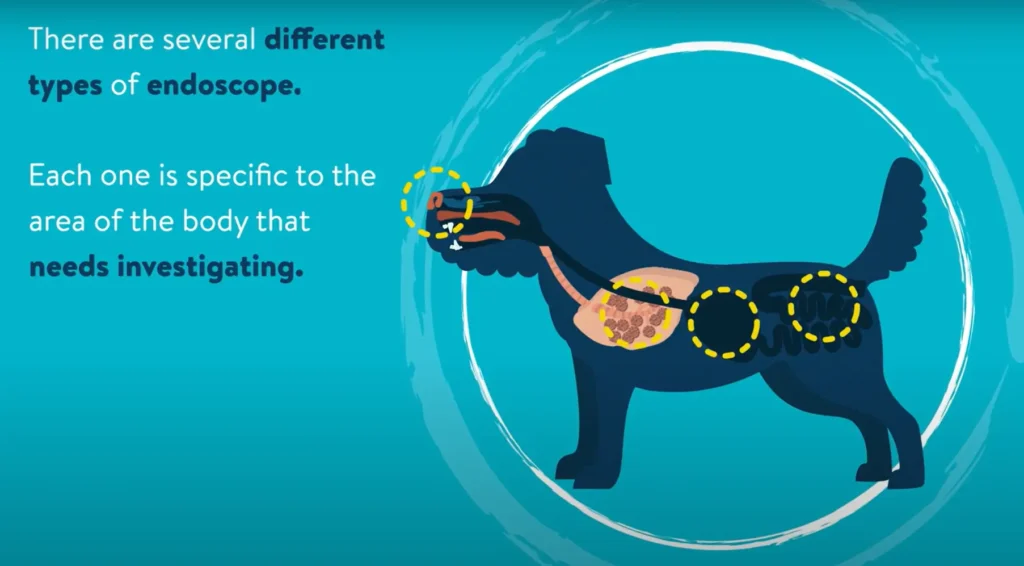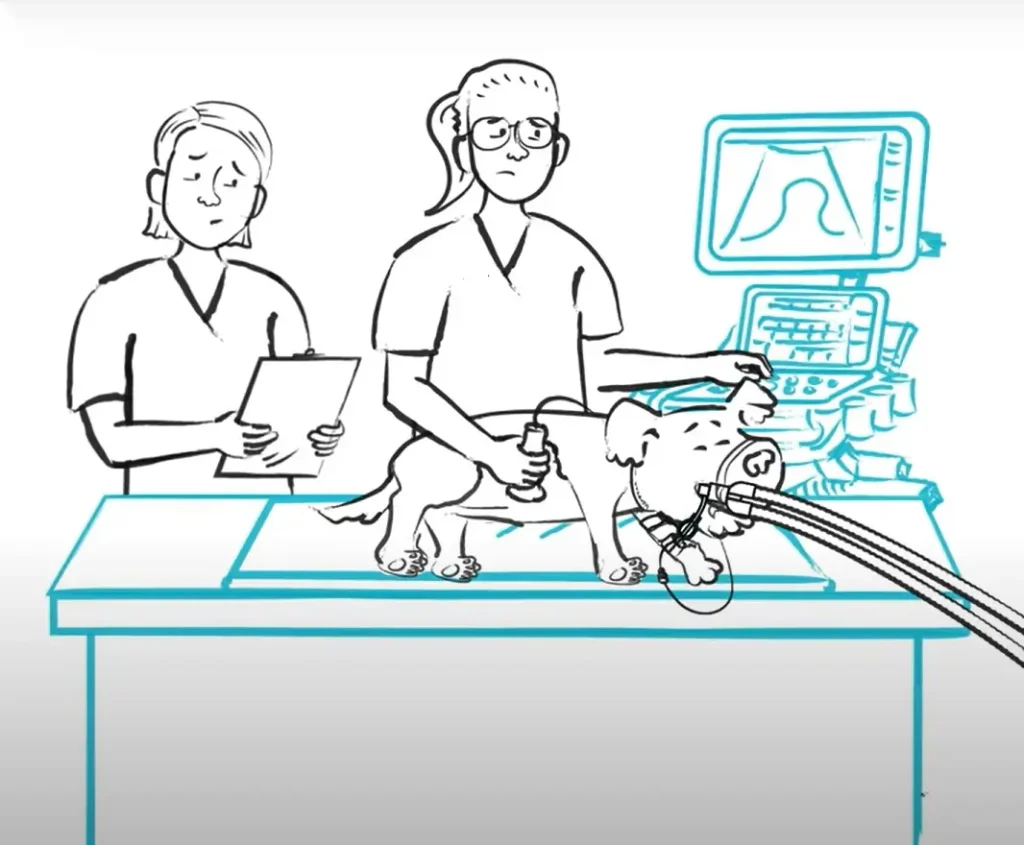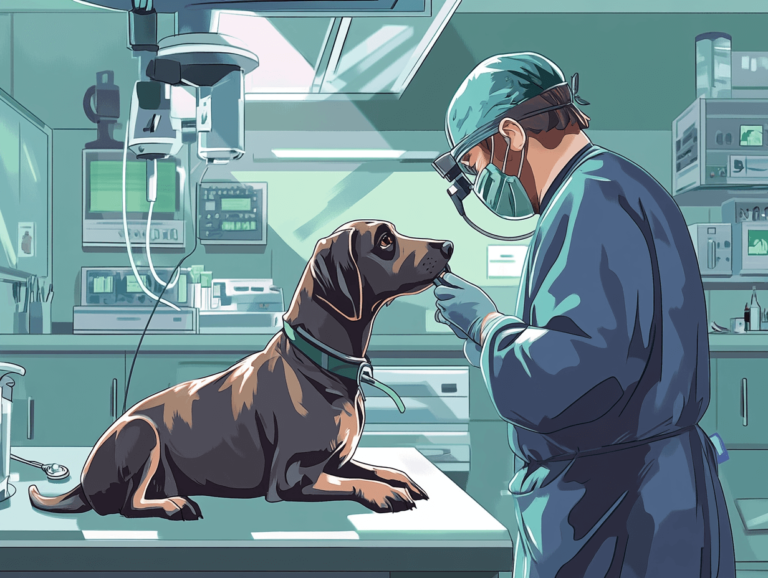Introduction
When it comes to diagnosing health issues in dogs, advancements in veterinary medicine have opened the doors to minimally invasive procedures like endoscopy. This groundbreaking technology allows veterinarians to see inside your dog’s body without the need for surgery. Whether it’s a gastrointestinal issue, foreign object removal, or respiratory concerns, endoscopy provides a clear picture and precise diagnostics, making it a trusted tool in modern veterinary care.
In this article, we’ll dive deep into endoscopy in dogs—what it is, how it works, its benefits, and potential risks. You’ll also learn about the costs involved and what to expect during the procedure. By the end, you’ll be well-equipped to make informed decisions about your dog’s health.
Understanding Endoscopy in Dogs
What is Endoscopy?
Endoscopy is a minimally invasive procedure used by veterinarians to examine the internal organs and tissues of dogs visually. This diagnostic tool employs a specialized device called an endoscope, which is a thin, flexible tube equipped with a light and a camera. The camera transmits real-time images onto a monitor, allowing the veterinarian to inspect areas such as the gastrointestinal tract, respiratory system, or even the urinary tract.
While originally developed for humans, endoscopy has become an integral part of veterinary medicine, providing a non-surgical alternative to traditional exploratory procedures. This approach minimizes discomfort, reduces recovery time, and provides faster answers for worried pet owners.
Types of Endoscopy Used in Dogs
Veterinary endoscopy encompasses several types, each designed to address specific health concerns in dogs:
- Gastrointestinal Endoscopy:
This is one of the most common applications, used to investigate symptoms like vomiting, diarrhea, or suspected blockages. It allows the veterinarian to examine the esophagus, stomach, and intestines. - Bronchoscopy:
Used to assess respiratory issues, bronchoscopy involves inserting the endoscope into the trachea and lungs. This can help diagnose infections, inflammation, or airway obstructions. - Rhinoscopy:
If your dog has chronic nasal discharge or nosebleeds, rhinoscopy can help identify causes like tumors, foreign objects, or infections. - Cystoscopy and Urethroscopy:
These procedures focus on the urinary tract, assisting in diagnosing bladder stones, infections, or abnormal growths. - Otoscopy:
For dogs with persistent ear infections, otoscopy allows for a detailed examination of the ear canal and drum.

When is Endoscopy Needed for Dogs?
Endoscopy is often recommended when other diagnostic methods, such as X-rays or ultrasounds, do not provide sufficient information. Here are common signs and situations where endoscopy may be necessary:
- Persistent vomiting or diarrhea
- Difficulty breathing or chronic coughing
- Foreign object ingestion
- Blood in the stool or unusual nasal discharge
- Unexplained weight loss or lethargy
- Recurrent ear or urinary tract infections
Endoscopy can also be a proactive measure, helping detect potential health issues before they escalate. Its versatility and precision make it an invaluable tool in veterinary diagnostics.
The Endoscopy Procedure for Dogs
Preparing Your Dog for Endoscopy
Proper preparation is crucial for a smooth endoscopy procedure. Your veterinarian will provide specific instructions, but here are common steps to follow:
- Fasting Requirements:
Dogs are typically required to fast for 12–24 hours before the procedure to ensure the stomach and intestines are empty. This allows for clearer visibility and reduces the risk of complications during anesthesia. - Hydration and Medication:
Your vet might recommend withholding water a few hours before the procedure. Additionally, discuss any medications your dog is currently taking, as some may need to be paused or adjusted. - Pre-Procedural Testing:
Bloodwork, X-rays, or ultrasounds may be conducted beforehand to assess your dog’s overall health and determine the exact location to examine during the endoscopy. - Sedation or Anesthesia:
Since endoscopy involves inserting a tube into sensitive areas, dogs are sedated or anesthetized to keep them comfortable and still throughout the process.
What Happens During the Procedure?
Once your dog is prepped, the endoscopy begins. Here’s an overview of what typically happens during the procedure:
- Introduction of the Endoscope:
The veterinarian carefully inserts the endoscope through a natural opening, such as the mouth, nose, or urethra. In some cases, a small incision may be made. - Visual Examination:
The camera on the endoscope provides real-time images of the targeted area. The vet uses these visuals to identify abnormalities such as inflammation, tumors, or foreign objects. - Biopsy or Foreign Object Removal:
If necessary, the veterinarian may use specialized tools attached to the endoscope to take tissue samples (biopsies) for further testing. Foreign objects, such as toys or bones, can also be removed during this step. - Duration of the Procedure:
Most endoscopies last between 20 minutes to an hour, depending on the complexity of the case and the findings.
Recovery and Aftercare
Once the procedure is complete, your dog will begin the recovery process. Here’s what to expect:
- Post-Anesthesia Monitoring:
After endoscopy, your dog will be monitored as the effects of sedation or anesthesia wear off. This period usually lasts a few hours, during which your dog may feel groggy or disoriented. - Dietary Adjustments:
Your veterinarian might recommend a bland diet for a day or two, especially if biopsies were taken. Avoid giving your dog hard or large meals immediately after the procedure. - Activity Restrictions:
Limit strenuous activity for the first 24–48 hours. This allows your dog’s body to fully recover from both the procedure and the effects of anesthesia. - Signs to Watch For:
While complications are rare, watch for unusual symptoms like excessive vomiting, bleeding, or difficulty breathing. If any of these occur, contact your vet immediately.
By following these guidelines, your dog should recover quickly and comfortably from their endoscopy.
Benefits and Risks of Endoscopy in Dogs
Benefits of Endoscopy in Veterinary Care
Endoscopy has revolutionized veterinary medicine, offering numerous advantages for diagnosing and treating health issues in dogs. Here are some key benefits:
- Minimally Invasive:
Unlike traditional surgical methods, endoscopy requires no large incisions. This significantly reduces pain, recovery time, and the risk of complications. - Accurate Diagnosis:
The real-time visuals provided by the endoscope allow veterinarians to precisely identify abnormalities, such as tumors, inflammation, or blockages. - Foreign Object Removal:
Endoscopy is often the safest and quickest way to remove ingested foreign objects, such as toys, bones, or other non-digestible materials. - Tissue Sampling for Biopsies:
Endoscopy enables the collection of tissue samples without invasive surgery, aiding in the diagnosis of conditions like cancer, infections, or chronic inflammation. - Short Recovery Time:
Since it’s a non-surgical procedure, most dogs recover quickly—usually within a day or two. This is a relief for both pets and owners compared to the longer recovery periods associated with surgery. - Reduced Costs:
While still an investment, endoscopy can be more cost-effective than exploratory surgery, especially considering the shorter recovery period and reduced need for post-operative care.
Potential Risks and Limitations
While endoscopy is generally safe, it’s essential to be aware of its potential risks and limitations:

- Anesthesia Risks:
Endoscopy requires sedation or general anesthesia, which carries inherent risks, particularly for older dogs or those with pre-existing health conditions. Pre-anesthetic testing can minimize these risks. - Minor Complications:
Some dogs may experience mild side effects, such as throat irritation, vomiting, or temporary discomfort at the site of insertion. - Limited Accessibility:
Endoscopy is not always available in all veterinary clinics due to the specialized equipment and expertise required. Referral to a specialist may be necessary. - Incomplete Diagnosis:
While endoscopy is highly effective, it may not be suitable for diagnosing all conditions. For example, issues located deep within solid organs or outside the endoscope’s reach might require additional diagnostic methods. - Cost Variability:
Depending on the procedure’s complexity and the area examined, costs can vary widely. While insurance can offset some expenses, it’s essential to be prepared for potential out-of-pocket costs.
By understanding these benefits and risks, pet owners can make well-informed decisions in consultation with their veterinarian.
Cost of Endoscopy for Dogs
The cost of endoscopy in dogs varies depending on the type of procedure, location, and additional services. Below is a table outlining the average costs for various types of endoscopy:
| Type of Endoscopy | Average Cost Range | Details |
|---|---|---|
| Gastrointestinal Endoscopy | $800–$1,500 | Examines the digestive system to diagnose issues like vomiting, diarrhea, or blockages. |
| Bronchoscopy or Rhinoscopy | $1,000–$2,000 | Used for diagnosing respiratory conditions or nasal issues like chronic discharge. |
| Cystoscopy or Urethroscopy | $1,200–$2,500 | Targets urinary tract or bladder-related concerns such as stones or infections. |
These costs usually include the procedure itself, anesthesia, and basic post-procedural care. However, additional charges may apply for services like biopsies or advanced diagnostic testing.
Factors Influencing Costs
Several elements can influence the total cost of an endoscopy procedure:
| Factor | Impact on Cost |
|---|---|
| Location of Clinic | Urban or specialized clinics often charge more than rural practices due to overhead and demand. |
| Type of Procedure | More complex procedures, such as cystoscopy or bronchoscopy, involve advanced tools and expertise. |
| Pre-Procedural Testing | Additional diagnostic steps like bloodwork, X-rays, or ultrasounds may increase the total expense. |
| Biopsies or Foreign Object Removal | Fees for laboratory analysis or the removal of items can further add to the overall cost. |
Is Pet Insurance Helpful?
Pet insurance can ease the financial burden of an endoscopy procedure. Many insurance plans cover diagnostic and treatment costs if the condition is not pre-existing. Below is a summary of how insurance can help:
| Insurance Consideration | Details |
|---|---|
| Coverage Scope | Confirm your plan covers procedures like endoscopy, including anesthesia and diagnostics. |
| Pre-Authorization | Some insurers require approval before advanced treatments to ensure coverage. |
| Out-of-Pocket Expenses | Without insurance, consider discussing payment plans or financing with your vet. |
Understanding the cost and financial aspects of endoscopy in dogs ensures you are prepared for this important diagnostic procedure.
FAQs About Endoscopy in Dogs
How Long Does an Endoscopy Take for Dogs?
The duration of an endoscopy procedure typically ranges from 20 minutes to an hour, depending on the complexity of the case and the area being examined. If biopsies or foreign object removal is required, it might take slightly longer.
Is Endoscopy Painful for Dogs?
Endoscopy is a minimally invasive procedure, and dogs are placed under sedation or anesthesia, ensuring they feel no pain during the process. Post-procedure discomfort is rare but may occur briefly in cases where biopsies are taken or foreign objects are removed.
Can Endoscopy Diagnose All Gastrointestinal Issues?
Endoscopy is highly effective for diagnosing many gastrointestinal conditions, such as inflammation, ulcers, or blockages. However, it may not detect issues deep within the intestinal walls or solid organs, requiring additional tests like ultrasounds or CT scans.
Are There Alternatives to Endoscopy for Dogs?
Yes, alternatives such as X-rays, ultrasounds, or exploratory surgery may be used depending on the condition. However, endoscopy is often preferred due to its non-invasive nature and ability to provide direct visuals of internal areas.
What Should I Feed My Dog After an Endoscopy?
After the procedure, your veterinarian may recommend a bland diet for 24–48 hours to ease digestion, especially if biopsies were performed. Gradually reintroduce your dog’s regular diet as advised by the vet.
Conclusion
Endoscopy in dogs is a vital diagnostic tool that offers a minimally invasive way to investigate and address a variety of health concerns. Its precision, safety, and reduced recovery time make it an excellent choice for diagnosing conditions like gastrointestinal issues, respiratory problems, or urinary tract concerns. By understanding the procedure, its costs, benefits, and potential risks, you can make informed decisions for your dog’s well-being. Always consult with your veterinarian to determine the best approach for your pet’s health.
